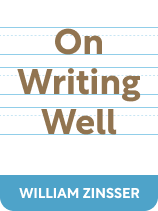

This article is an excerpt from the Shortform book guide to "On Writing Well" by William Zinsser. Shortform has the world's best summaries and analyses of books you should be reading.
Like this article? Sign up for a free trial here .
Do you feel discouraged when your first draft doesn’t come out perfect? Do you feel like you’ve failed if you need to write a second draft?
Having to write a second draft doesn’t mean you’ve failed. In fact, the best writers revisit their works many times. Writing a second draft is how you find cluttered writing, clarify your ideas, and simplify your sentences.
Here’s why you should embrace rewriting.
Embrace Rewriting
While you should strive to write with simplicity, don’t expect your first draft to be perfect—there will be clutter and imprecise words in your draft that you’ll need to edit. In his book On Writing Well, William Zinsser says that you should embrace rewriting. By writing a second draft, you’ll find better, simplified ways of expressing your ideas.
While many writers avoid rewriting, Zinsser believes all great writers revise their work—no one writes a masterpiece on the first try. Rewriting is part of the writing process, so don’t skip this crucial step.
(Shortform note: If you’re worried that needing to rewrite means you’re not a talented writer, don’t: Most great artists refine their work from the first draft to the final product as Zinsser recommends. Some never stop fine-tuning their art: Leonardo Da Vinci worked on versions of the Mona Lisa for years up until his death.)
Zinsser explains that to rewrite, use your first draft as a guide, and restructure confusing sentences. Delete clutter, and rephrase words or sentences that could be more succinct.
Additionally, test the simplicity of your writing by reading your work out loud. Reading your writing out loud will indicate which sentences need reworking. If you trip over words or phrases, it’s a sign to rewrite it more simply.
| Try Stephen King’s Rewriting Process If you’re having difficulty rewriting—and most writers do—don’t get discouraged. Finding your rewriting style takes time. Many famous writers have their own unique methods of writing a second draft. For example, Joan Didion marked edits at night after a day of writing and then made those edits the next morning to kickstart another day of writing. In On Writing, Stephen King outlines his revision process from beginning to end: 1) After you finish your first draft, King suggests taking at least six weeks to work on other pieces before you start writing a second draft. During this time, resist the temptation to read your draft. The point is to distance yourself from the draft, so you can be a more objective critic when you revise. 2) After six weeks, read the draft in one sitting, if possible. Note fixes for specific issues, like deleting adverbs. Also ask yourself big-picture questions. What is the piece about? Is there a theme? Are there recurring elements? Is the story coherent? 3) Go back through and revise for your second draft. Fix small issues and polish your big picture ideas. 4) After you finish, give the second draft to a small group of readers you trust. Listen to their feedback. Incorporate the feedback as you like. The result can be your next draft, or even your final draft. 5) Use however many revision cycles you’re comfortable with. King’s standard process takes two drafts and a final polish. The next time you sit down to rewrite, consider using Stephen King’s process. |

———End of Preview———
Like what you just read? Read the rest of the world's best book summary and analysis of William Zinsser's "On Writing Well" at Shortform .
Here's what you'll find in our full On Writing Well summary :
- A back-to-basics approach to the craft of writing
- How to practice simple, clear, and engaging writing—even if you're not a writer
- How to effectively put your ideas into words






